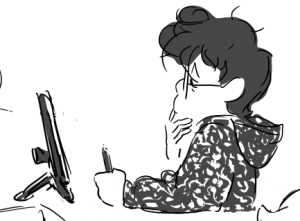I was thinking about how many artists and content creators make use of social media sites specializing in sharing such as tumblr, Deviant Art (which has frankly been waining in popularity), Soup (a newcomer to the scene), and Pixiv (a Japanese outlier), to get their material out there. Some people post on these sites as part of their hobby, for some they are hoping to break into a scene, and others make these sites their very livelihood. These creators range in profession from storyboard artists and showrunners for major television networks to professional comic authors to amateur/hobbyist illustrators. For some their content is their job, for others it is their passion, and for a lucky few it is both.
All of these sites have their own unique interfaces and qualities, but they all provide a very basic means for its users to indicate a level of approval for the content that is posted and then disseminate said content among other viewers. All of these sites also attract a wide range of content creators from many different regions. Off the top of my head, on tumblr I follow an artist in Arizona, two in Germany, a handful in Japan, one in Aruba, a bunch in New York and New Jersey, a sizable chunk in California, two or so in Mexico, one in Spain, an Englishman, and I think an Australian or two. Many of these content creators have followers ranging from tens, to hundreds, and some of them have thousands. Their styles are disparate (though their seems to be a general commonality in their age range), though their followers intersect like hundreds of tiny venn diagrams.
The data I wish to extrapolate is where are the people that are “liking” this content? Is there any correlation between the content posted and where the people are that “like” it? Is there any commonality between where a content creator is from and where her or his fans are from? On a site like tumblr content posters can add tags for those searching for a certain subject, but it’s a rather crude system and when someone reblogs a picture the tags are rarely maintained. I still need to figure out the logistics, but I want to try and map regional data with tags and content creators and see how it all connects.
As an aside, I also saw a curious news item on a Spanish retro-gaming blog (http://www.repisanintendo.cl/post/101105828474/japon-podria-comenzar-a-enfrentar-un-irreversible). The basic gist is that with the rise in interest in retro gaming from various podcasts, collectors, YouTube personalities and and the like, it seems that Japan’s vintage game stores, particularly in Tokyo have been seeing their stock become rapidly depleted by tourist collectors. I can’t put my finger exactly on what data to extract from this or how, but I feel like there’s something fascinating to be found.



Renzo,
I’ve spoken to at least one other person in our class who was interested in social media data connected to place. Do we know if social media data is inherently tracked (by IP, user identified, etc)? There’s a visualization on twitter that makes me think that this answer is “yes”: http://srogers.cartodb.com/viz/4a5eb582-23ed-11e4-bd6b-0e230854a1cb/embed_map
Privacy is another issue for social media tracking data. That is, my Instagram is private, because I started seeing my weird, square Instagrams being used as endorsements for check-ins around Internet (after Googling my own name –confession). The company suggested that if I didn’t want to have my data pulled to make recommendations “for tourists” that I should make my Instagram private. ZOMG!
This means that on other platforms, too, the full story of a conversation (or like history) is altered depending on primary account holder. For the Ferguson/Twitter example above, if a person with a private account participated, were they counted? Is that an issue that matters? (Maybe not, but it’s interesting to think about).
I began thinking about this again recently with Lev’s Selfiecity. There are a lot of personal photos on that site! What if you found yourself on there?
Renzo,
I think that tracing communities interested in art–particularly art that might exist outside the exclusive and highly structured high art world–is a really fascinating project.
And Kelly–gotta agree with you there, I think there can be something truly creepy about finding yourself online in ways you have not endorsed because someone is mining data, and there are serious ethical implications to projects like Selfiecity which can be viewed more or less as an extension of the male gaze.
But for your project, Renzo, it seems like Kelly’s comment about “full story” is pertinent–how do you account for potential omissions in data because users are set to private? Is there a correlation between types of artists who attract private users, even? Lots of questions there.
Looking forward to more,
MC